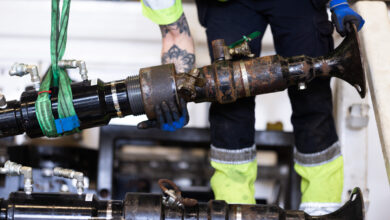IMO begins Deepwater Horizon casualty investigation
The International Maritime Organization (IMO) officially initiated an investigation of the Macondo incident during the 21st session of the organization’s Subcommittee on Flag State Implementation on 4 to 8 March. The group considered the marine investigation reports by the United States and the Republic of the Marshall Islands related to the explosions, fire and loss of the Deepwater Horizon rig. Several issues and considerations were identified relating to fire protection; design and equipment; stability; training; and oversight. Pending endorsement by the IMO Maritime Safety Committee, the reports on the Macondo incident, as well as the analysis and comments of the subcommittee, will be forwarded to IMO technical subcommittees for more detailed review and action.
Alan Spackman, vice president of IADC’s Offshore Division, represented the association at the meeting. Warren Weaver, Transocean, and Tom Horan, Rowan Companies, also attended as members of the delegations of Vanuatu and the Marshall Islands, respectively.
Specific highlighted issues and recommendations to be forwarded for further consideration are:
Fire protection:
- Gas detectors installed in the ventilation inlets and other critical locations were not set to automatically activate the emergency system that would cause the engines to stop the flow of outside air into the engine rooms.
- The design of the main and emergency power sources did not adequately take into account that the proximity of the air inlets to one another created a risk for flammable gases to impact all six generators at once.
- The MODU did not have sufficient barriers to provide effective protection for the crew. An explosion risk analysis should be conducted to determine whether the barriers around a MODU’s accommodation areas, escape paths and embarkation stations provide adequate protection.
- The main fire system depended exclusively on electric motor-driven fire pumps and was rendered useless when the explosions caused a total loss of power.
- The spread of the fire after the explosions was not limited by the “A-class bulkheads” on the MODU.
Considerations:
- Implement clearer requirements for labeling and control of electrical equipment in hazardous areas and the continued inspection, repair and maintenance of such electrical equipment.
- Provide more detailed guidance for the design and arrangement of gas detection and alarm systems that will also identify recommended automatic and manual emergency shutdown actions to be performed following gas detection in vital areas.
- Ventilation inlets for machinery spaces containing power sources should be located as far as possible from hazardous locations.
- Installation of a fixed water deluge system to fight fires on or near the drill floor, which may automatically activate upon gas detection.
- Installation of hydrocarbon fire-resistant bulkheads between the drilling area, adjacent accommodation spaces, and spaces housing vital safety equipment.
- Implement standards on the maximum allowable heat exposure for personnel at the muster stations and lifeboat/life raft lowering stations.
Design and equipment:
- The current lifeboat design and testing requirements did not adequately ensure the safe loading of a stretcher or permit adequate seating to accommodate the average offshore worker.
- The life raft launch area had no effective barrier to shield it from the intense heat of the fire that threatened to incinerate the life raft.
Considerations:
- Equip MODUs with a non-electrically powered fire pump to provide fire main pressure during a loss of electrical power.
- Consider the need for a fast rescue boat/craft onboard MODUs.
Stability:
- Massive quantities of water were directed toward the MODU without careful consideration of the potential effects of water entering the hull.
- Rig owner’s personnel engaged in the emergency response were not familiar with the vessel response plan and deviated from it in their selection of a salvage company.
Training:
- The dual-command organizational structure put the offshore installation manager in charge when the vessel was latched onto the well and the master in charge when the MODU was under way between locations or in an emergency situation. This led to a command confusion at a critical point at the time of the emergency and may have impacted the decision to activate the emergency disconnect system.
- The onboard management team and crew had insufficient training and knowledge to take full responsibility for the safety of the vessel.
Considerations:
- Require the crew to practice launching life rafts during evacuation drills.
- Clearly designate a person in charge under both operating and emergency conditions for MODUs.
Oversight:
Considerations:
- Evaluate the need to require flag States to audit classification societies acting on their behalf as recognized organizations and the development of a code of conduct for recognized organizations.
- Develop a communication system between the relevant flag and coastal State regulatory bodies to address issues regarding units operating within the coastal State’s jurisdiction.
The timing of consideration of these issues by IMO’s technical subcommittees remains uncertain due to ongoing efforts to restructure and reform the subcommittees, but it is expected to begin in early 2014. It is expected that both the Marshall Islands and the United States will make submissions to the IMO regarding the contents of reports and the safety-related issues noted above and will propose specific amendments to the MODU Code.




